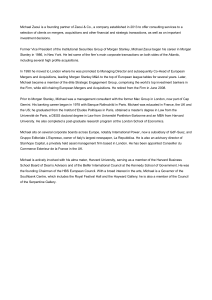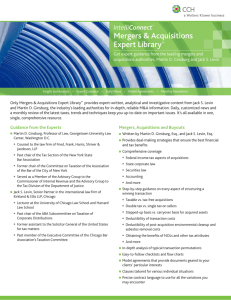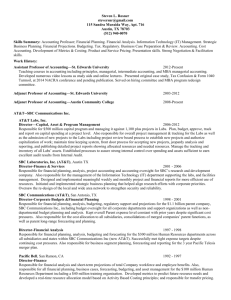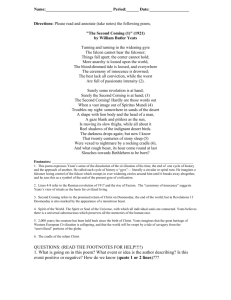Mergers and Acquisitions - Darden Faculty
advertisement
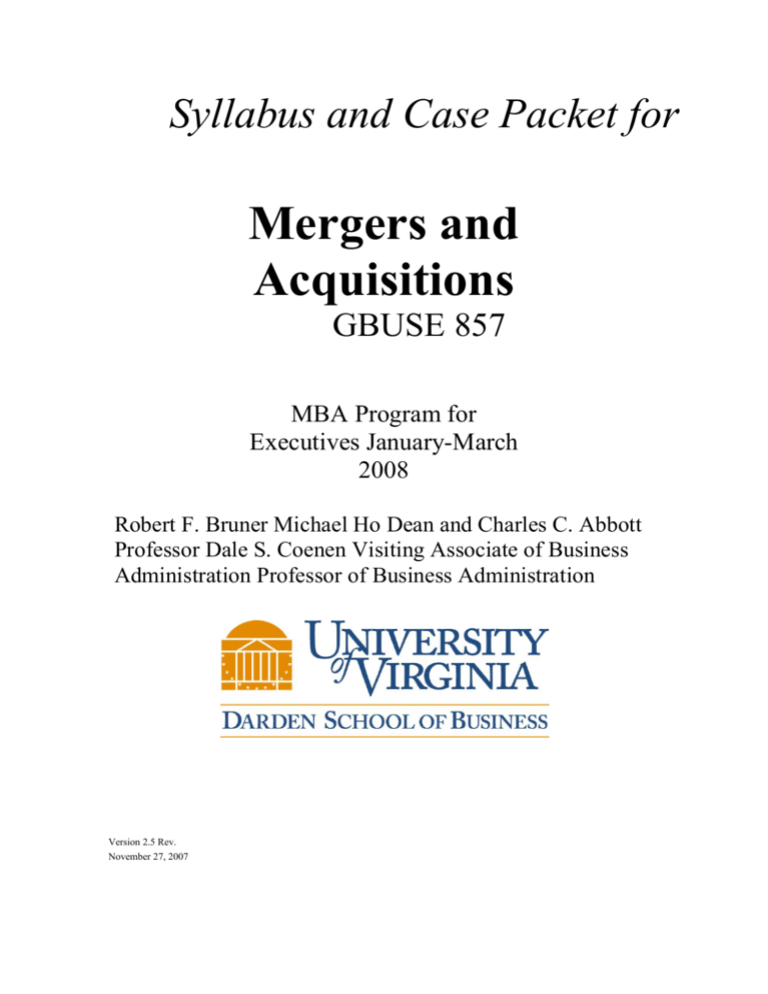
Syllabus and Case Packet for Mergers and Acquisitions GBUSE 857 MBA Program for Executives January-March 2008 Robert F. Bruner Michael Ho Dean and Charles C. Abbott Professor Dale S. Coenen Visiting Associate of Business Administration Professor of Business Administration Version 2.5 Rev. November 27, 2007 Mergers & Acquisitions GBUSE 857 Robert F. Bruner and Michael J. Ho Course Introduction and Syllabus for: MERGERS AND ACQUISITIONS (GBUSE 857, January-March 2008) Dean Robert F. Bruner Professor Michael Ho Saunders Hall, Dean’s Office tel: 924-7481 Faculty Office Building, (TBA) tel: 973-9881 email: brunerr@virginia.edu email: hom@darden.virginia.edu website: http://faculty.darden.edu/brunerb/ website: www.clb-partners.com/team-ho.phtml Course Mission and Goals The mission of this course is to survey the drivers of success in mergers and acquisitions (M&A) and develop your skills in the design and evaluation of these transactions—thereby the course complements a number of other courses in the Darden curriculum and supports Darden’s mission to ―better society by developing leaders in the world of practical affairs.‖ In pursuit of this mission, this course guides you to: 1 Master the language and processes of M&A. Basic knowledge about the field of M&A is the foundation for effective work in a wide range of fields including corporate development, investment banking, consulting, and advising senior management. Class discussions, the textbook, and the practical experience of the instructors will help you master the basics. 2 Identify M&A issues worth attention. The next stage of professional competency is to develop an instinct for the problems and opportunities in an M&A situation. This course highlights elements in the structure and process of every M&A transaction that deserve professional scrutiny. 3 Analyze an M&A transaction rigorously. Valuation analysis is the core skill in M&A and is supplemented by analyses of strategy, dilution, financing, and risk management. The course will exercise analytics in these areas. 4 Develop a concept, design a deal, and present a proposal for an M&A transaction. All transactions begin with the spark of an idea. Translating that idea into a concrete proposal takes hard work. Doing so teaches a lot about the drivers of M&A success, and the elements of deal design. Designing a transaction requires skills of analysis and negotiation. We will survey a number of analytic tools, and then exercise them and your presentation skills in a simulated negotiation exercise. The work in this exercise will teach you a great deal about the design process, and the important leadership skills called for. We will survey some strategic frameworks useful in M&A, and the steps necessary to translate a concept into a solid proposal. 5 Form an opinion about a proposed deal. The key aim of any university education should be an ability to think critically, to form a ―view‖ of events and circumstances. Training in M&A should settle for nothing less. We will review a Mergers & Acquisitions GBUSE 857 Robert F. Bruner and Michael J. Ho framework about deal design, and apply it to several cases. This will be the focus of the individual papers. The subject is complex, competition in M&A is intense, and the consequences of error are large. If you tackle this course earnestly, you will learn a great deal. At the same time, your learning will be deeper and more effective if you engage the course in the spirit of invention and curiosity. The course will argue that deal design is fundamentally a creative effort. The best creativity happens in an environment that is both demanding and fun. Your instructors intend to promote this; you should too. Focus of study M&A will draw on cases and examples with the following leanings: -Both public and privately-held companies. -Mainly oriented to finance, though the course will draw in contributions from accounting, law, strategy, organizational behavior, and game theory. -Primary attention will be given to U.S. laws and regulations. -Mainly oriented to transaction design, rather than the development of long-term policies. The course assumes familiarity with valuation analysis, financial analysis, and accounting. The intent is to build upon the work of all Darden courses you have had. Scope of ideas The course holds that success in M&A is defined first and foremost in the creation of economic value and also in terms of outcomes such as enhanced financial stability, improved competitive position, strengthened organization, enhanced reputation, and observance of the letter and spirit of laws and ethics. These kinds of outcomes are the fruits of two important influences:Structure of the environment in which the deal takes shape. This includes the nature of the economic opportunity, the strategic setting of the buyer and target, the nature of the organizations of the buyer and target, the reputations of the players, and the matrix of laws and ethical norms surrounding the firms.Conduct of the players. Given the constraints and opportunities in the environment, how you play the M&A game significantly shapes outcomes. We will explore the influence of conduct in areas such as acquisition search, due diligence, negotiation and bidding, dealing with laws, regulations, and the judicial system, deal design, post-merger integration, communication, and management of the deal development process. In short, the course presents a considerably richer view of M&A than you will have seen in previous courses and newspaper or magazine articles. Mergers & Acquisitions GBUSE 857 Robert F. Bruner and Michael J. Ho Course Requirements and Grading The final grade in the course will be determined with these components and weights: 35% Class participation. Regular attendance and participation are expected. Absence from the exercises or from more than two classes for reasons other than personal illness, family emergency or other seriously extenuating circumstance will materially affect the class participation grade. Please call or e-mail the instructors to explain absences. 25% Individual paper. During the two interstitials, you will prepare a brief memo describing the competitive landscape of your company’s industry, the growth opportunities set for your company, the role of M&A in achieving your company’s growth objectives and the desirable attributes of a potential counterparty for your company. 10% Two exercises. You will be required to submit your individually prepared solutions to the HP/Compaq (A) case and the Definitive Agreement Review. 20% Group paper. In teams of no more than three, each group will prepare a brief analysis and memo during the final exams period. This exercise will test your ability to assess the success of a transaction as well as structuring appropriate terms and conditions in a transaction. 10% Peer evaluation. Your contribution to the two team activities, Yeats Valve/TSE International negotiations and the group paper will be assessed by your teammates and incorporated into your overall course grade. 100% Total Tips on how to engage the course 1. Diversify. The course offers a number of learning modes. Engage them all. The plan for the course shows that regular case studies will be the focus of 6 of the class meetings. The other four include the deal proposal exercise and a discussion of technical material. 2. Follow your interest. This is a ―self-tailoring‖ course in that it leaves much of the technical reading to the discretion of the student. The textbook will give you the framework of terminology and tools in M&A. Consider reading carefully where you find interesting topics. 3. Join a learning team to prepare for class. The ideas in the cases and readings for class are deep; the analysis can get complex. You will learn more from the course, and perform better in class participation by discussing these cases together in a learning team. Mergers & Acquisitions GBUSE 857 Robert F. Bruner and Michael J. Ho Bob Bruner and Michael Ho will serve as a clearinghouse for those students who have been unable to join a learning team. 4. Commit to your project and learning teams. Team-based work makes up a significant part of the course. The team project accounts for 20% of the final grade. Class participation (which can be enhanced by learning team work) accounts for 35%. High performance teams show a number of common attributes: 1 Members commit to the success of the team. 2 The team plans ahead, leaving time for contingencies. 3 The team meets regularly. 4 Team members show up for meetings and are prepared to contribute. 5 There may or may not be a formal leader, but assignments are clear. Team members meet their assigned obligations. About the instructors Bob Bruner has been a Darden faculty member for 25 years. His writing and research are in corporate finance, particularly M&A where he has various projects in development. His book, Deals from Hell, addresses failures in M&A. Most recently, he co-authored The Panic of 1907: Lessons from the Market’s Perfect Storm with Sean Carr. He likes to explore Virginia waterways by canoe and kayak. Find more about him at http://faculty.darden.edu/brunerb/. Michael Ho has been a Darden faculty member for the past eight years and previously served on the finance faculty at Babson College for five years. He is a Managing Director of CLB Partners, LLC, a merchant bank focused on providing mergers and acquisition advisory services to middle market companies and acquiring select companies, primarily in distribution and staffing. Prior to co-founding CLB Partners, he was a Principal in Mergers and Acquisitions and Director of Asia-Pacific Investment Banking at Robertson Stephens & Company, a leading financial adviser to emerging growth companies in the high tech and healthcare industries. Before joining Robertson Stephens, Michael was in the Mergers and Acquisitions department at The First Boston Corporation. Michael earned his Ph.D. in finance from the University of Virginia, an S.M. (Finance) and S.B. (Materials Science) from the Massachusetts Institute of Technology. Mergers & Acquisitions GBUSE 857 Robert F. Bruner and Michael J. Ho Course Overview Class # Date Pre-work 10 days 1 January 25 2 January 26 Materials Topics M&A activity Process Overview The Practice of M&A: Why M&A? Hugh McColl and NationsBank Strategy, leadership and post merger integration. Bank One - 1993 Synergy Exercises: NASDAQ/OMX and Sirius/XM Radio Identifying and valuing synergies; implementing PMI initiatives to achieve synergies. Guest Speaker – Synergies and PMI Interstitial 12 days HP/Compaq (A) M&A valuation The Deal Is a System: Deal Structuring 3 February 7 HP/Compaq (A) Omni Services (Revised) M&A valuation Private company M&A issues 4 February 8 Haney Systems Legal, tax and transaction structure issues 5 February 9 HP/Compaq (B) HP/Compaq (C) Deal terms Social issues The Dynamics of Deal Formation Interstitial 20 days Definitive Agreement Review and Exercise Prep Yeats Valve 6 February 29 Yeats Valve Briefing (dual track) Merger negotiations 7 March 1 Finals Period Debrief Yeats Valve Revisit Hugh McColl and NationsBank Multi-issue bargaining and negotiation Reassess acquisition strategy, negotiation style and transaction structure; Defining deal ―success‖ 9 days At the opening of negotiations Walk-away prices Yeats Valves TSE International Exchange Ratio $_____.___ per share This is your opening offer/asking price per share of Yeats Valves at the start of negotiations. $_____.___ per share This is your opening offer/asking price per share of TSE International at the start of negotiations. ____.___ shares of TSE International per share of Yeats Valves ____.___ shares of Mergers & Acquisitions GBUSE 857 Robert F. Bruner and Michael J. Ho Assignment for Friday, January 25, 2008 Digital Case: Hugh McColl and NationsBank: Building a National Footprint Through M&A (UVA-F-1398M) Instructions for viewing this digital case study are contained on the CD itself. Please insert the disk into the CD drive of your computer. The case will start automatically. Case: Bank One – 1993 (HBS 9-394-043) Questions for advance preparation 1 How did growth by acquisition transform NCNB (later NationsBank) from 1982 to 1998? 2 To what changes in the industry did this strategy respond? Compare and contrast the strategies employed by NationsBank and Bank One to address these changes. 3 How well did the strategy of growth by acquisition serve the shareholders of NationsBank? On what basis do you draw this conclusion? 4 Specifically, what was Hugh McColl’s approach to M&A negotiation and integration? How does that compare to John McCoy’s? 5 To what do you attribute the relative success of the firm’s acquisition program? 6 Would this approach be effective in other firms and industries? Why? Mergers & Acquisitions GBUSE 857 Robert F. Bruner and Michael J. Ho Assignment for Saturday, January 26, 2008 Guest Speaker: TBA Exercise: Estimating Synergies: NASDAQ/OMX and Sirius/XM Radio Reading: Pages 325341, Chapter 11, ―Valuing Synergies,‖ Applied Mergers and Acquisitions. Questions for advance preparation 1 Estimate the value of the potential synergies for the NASDAQ/OMX and Sirius/XM Radio transactions. 2 How do these benefits compare to the premia offered? 3 What are the key drivers of synergy value in your analysis? 4 How should the potential synergies in these deals affect the design of the postmerger integration strategy? Mergers & Acquisitions GBUSE 857 Robert F. Bruner and Michael J. Ho Assignments for January 27 – February 6, 2008 The course assignments during this period consist of two items: (1) responses to assignment questions about the case, ―The Merger of Hewlett-Packard and Compaq (A)‖, and (2) Individual Paper (A). Case: ―The Merger of Hewlett-Packard and Compaq (A): Strategy and Valuation‖ (UVAF1450) Reading: Chapters 8, 9 and 15 in Applied Mergers and Acquisitions. Supporting spreadsheet: Valuing_synergies.xls Questions: To be submitted via email no later than 5:00 p.m. February 1, 2008: 1 What is the total value of the synergies projected by HP and Compaq? Note that ―valuing synergies.xls,‖ can automate your analysis. 2 What is a reasonable valuation range for Compaq? Individual Paper (A) Topic: M&A, competitive landscape and strategy. Subject: Your company, or, if your company is not appropriate and subject to instructor approval, a company of your choosing. Due: No later than 5:00 p.m. February 6, 2008. Maximum length: Five typewritten pages of text, 12-point font, one-inch margins. No limit on number of exhibits, though the readers will view weak or unnecessary exhibits as an indication of poor organization and communication and will mark the paper accordingly. Mergers & Acquisitions GBUSE 857 Robert F. Bruner and Michael J. Ho Questions to address: 1 What are the key competitive forces shaping your company’s industry? What role has M&A played in your company’s industry? 2 How is your company positioned in the industry? How will your company achieve its growth objectives? 3 What opportunities and/or challenges may motivate your company to pursue an inorganic growth strategy? 4 What are the alternatives to M&A to consider? What are the opportunities and/or challenges of these alternative inorganic growth strategies? Mergers & Acquisitions GBUSE 857 Robert F. Bruner and Michael J. Ho Assignment for Thursday, February 7, 2008 Case: ―Omni Services‖ (Revised) (UVA-F-0438) Reading: Chapter 18 in Applied Mergers and Acquisitions. Questions for advance preparation 1. Why should Textiles acquire Omni? 2. Why should Omni consider selling? Why now? 3. What specific issues and challenges need to be addressed in (i) the discussions and (ii) the process? 4. What advice would you give to Omni and specifically to N.B. Martin? Mergers & Acquisitions GBUSE 857 Robert F. Bruner and Michael J. Ho Assignment for Friday, February 8, 2008 Case: ―Haney Systems‖ Reading: Chapter 25 in Applied Mergers and Acquisitions. Question for advance preparation 1. What key issues and problems can you identify that must be addressed in the negotiations and in the Definitive Agreement? Be specific in developing your list. Consider issues in areas such as: Economics (i.e., price and related factors) Legal Tax Organizational Mergers & Acquisitions GBUSE 857 Robert F. Bruner and Michael J. Ho Assignment for Saturday, February 9, 2008 Cases: ―The Merger of Hewlett-Packard and Compaq (B): Deal Design‖ (UVA-F-1451) Readings: in Applied Mergers and Acquisitions Pages 531-546: ―Introduction to Deal Design‖ Pages 547-550: ―Choosing the Form of Acquisitive Reorganization.‖ See also Exhibit 19.3, and section on reverse triangular merger, pages 556-57. Pages 668-683: ―Social Issues‖ This case discussion will assess the specific terms of merger of HP and Compaq. Are these terms right for this deal? Use all of the tools and concepts we have surveyed to assess the attractiveness of this term sheet. Questions for advance preparation 1 Given the acquisition premium, how dependent is HP on the expected synergies for this deal to be economically attractive to HP shareholders? Please estimate the EPS dilution in this deal. 2 How do the terms of merger allocate power in the board and management of the new firm? Is this a merger of equals or a takeover? By whom and of whom? Is this a true merger of equals? Does one side seem to emerge with more power than the other? 3 Assess the appropriateness of the exchange ratio proposed in this deal. In terms of the relative contributions of the two firms, is the exchange ratio fair to HP shareholders? 4 Consider the entire set of terms: is this a good deal? If so, for whom? 5 How should Kathryn Macalester vote her shares? Mergers & Acquisitions GBUSE 857 Robert F. Bruner and Michael J. Ho Assignments for February 10-28, 2008 Exercise: Definitive Agreement Review Assignments: 1 Complete the study questions in the Definitive Agreement Review. To be submitted via email no later than 5:00 p.m. Sunday, February 17, 2008. 2 Individual Paper (B) Individual Paper (B) Topic: M&A process and structure. Subject: The same company analyzed in Individual Paper (A). Due: No later than 5:00 p.m. February 28, 2008. Maximum length: Five typewritten pages of text, 12-point font, one-inch margins. No limit on number of exhibits, though the readers will view weak or unnecessary exhibits as an indication of poor organization and communication and will mark the paper accordingly. Questions to address: 1 Is your company more likely a buyer or seller? Why? 2 What are the key attributes of your company that make it an attractive buyer or seller? 3 What are the desirable attributes of a potential buyer of the company or target for the company? 4 Identify a specific candidate and explain why this potential buyer or target is a preferred choice. 5 Describe the potential approach to this counterparty. To whom would you contact? What would your ―script‖ be to motivate the discussions? 6 What specific structuring issues would be important to you in the negotiations? Mergers & Acquisitions GBUSE 857 Robert F. Bruner and Michael J. Ho Assignments for February 10-28, 2008 (cont’d) Case: Yeats Valves and Controls, Inc. (UVA-F-1365) and TSE International (UVA-F1366) You will be assigned to a merger negotiation team (to be distributed) representing one side of negotiations between TSE International and Yeats Valves. Your goal in this negotiation should be to represent your firm effectively and to maximize value for your firm’s shareholders. Careful analysis and artful negotiation will accomplish these goals. A schedule for the activities in this exercise is attached. Objectives Our objectives in conducting this exercise are (1) to illustrate techniques of merger evaluation, (2) to consider the interplay between strategic and financial considerations in arriving at satisfactory merger terms, and (3) to explore creative structuring solutions for possible use when the expectations of buyer and seller have little common ground. Team Information and Preparation Each side of the negotiation will receive a separate case study and Excel spreadsheet file containing private information for your team only. If you wish, you may divulge this th information to your counterparty in the negotiations on Friday, February 29 , but not before. You should study on your own the case assigned to your side of the negotiations. We will hold th briefing sessions for the two sides independently in class on the 29 . Teams will need to submit a report no later than 5:00 p.m. Thursday, February 28, 2008 stating their opening asking prices for the assets of their own firms (in millions of dollars, not per-share figures) and the prices below which they will abandon negotiations. At the same time, the TSE International teams will need to give the instructors a report stating their opening and walkaway values between which they will attempt to strike a deal for their own shares. All teams are requested to present an analysis justifying their walk-away prices. A standard form for these pre-negotiation reports follows — please note that this report requires you to submit a completed DCF analysis. This information will be kept confidential until the debriefing, when it will be used in an analysis of the negotiations. Remember, this is a simulation. There is no script that you are to follow. The results are entirely of your own making. Mergers & Acquisitions GBUSE 857 Robert F. Bruner and Michael J. Ho Study Questions for Advance Preparation The following questions will help focus your preparation: 1 What do you believe Yeats Valves is worth? What key financial assumptions determine the range of high and low values in your valuation analysis? Also, draw on any other valuation approaches and information that you can. 2 What are the advantages and disadvantages of a combination between Yeats Valves and TSE International? What is your best alternative to a negotiated agreement with your counterparty? 3 What risks do TSE International and Yeats Valves face in this proposed merger? Consider a range of transaction, financial, and operating risks. What effect do these risk factors have on the value of Yeats Valves? 4 From your perspective as a negotiator for your company, what are your goals in this negotiation? What do you expect are the goals of the other team? 5 Develop a negotiating strategy, including an identification of your opening and walk-away bid (ask) prices. The prenegotiation report will require you to justify your walkaway price. Confidentiality of Information and Results Two informal rules will increase your learning in this exercise and make it more realistic to you: • Respect the confidentiality of your and your counterparty’s information. Once negotiations begin, you may choose to reveal your information and/or ask to see your counterparty’s information. (Note that doing so has important strategic implications, about which you should think carefully.) Until negotiations begin, stick to your own information. • Do not research the actual outcome of the deal or the performance of the companies since the date of the case. One should aim to learn to create original deal structures, rather than imitate the deals of others. Also, what actually happened may not have been the right course of action. Mergers & Acquisitions GBUSE 857 Robert F. Bruner and Michael J. Ho Assignment for Friday, February 29, 2008 DUE NO LATER THAN 5:00 p.m. THURSDAY, FEBRUARY 28, 2008 Confidential Prenegotiation Team Report Your team: (check one) TSE International________; Yeats Valves________ World __________________ Team-members’ names: ___________________________________________ Report your opening and walk-away prices for Yeats Valves and TSE International and the resulting exchange ratio. Please assume a share-for-share exchange for the purposes of reporting here only (though you are free to negotiate entirely different terms of payment, if you like). Please quote all bid and asking values in U.S. dollars per share of each firm’s stock. This convention simply puts all initial prices reported here on a similar basis. You need not restrict your negotiations, bids, or transactions to this type of transaction. Class # Date Pre-work 10 days 1 January 25 2 January 26 Materials Topics M&A activity Process Overview The Practice of M&A: Why M&A? Hugh McColl and NationsBank Strategy, leadership and post merger integration. Bank One - 1993 Synergy Exercises: NASDAQ/OMX and Sirius/XM Radio Identifying and valuing synergies; implementing PMI initiatives to achieve synergies. Guest Speaker – Synergies and PMI Interstitial 12 days HP/Compaq (A) M&A valuation The Deal Is a System: Deal Structuring 3 February 7 HP/Compaq (A) Omni Services (Revised) M&A valuation Private company M&A issues 4 February 8 Haney Systems Legal, tax and transaction structure issues 5 February 9 HP/Compaq (B) HP/Compaq (C) Deal terms Social issues The Dynamics of Deal Formation Interstitial 20 days Definitive Agreement Review and Exercise Prep Yeats Valve Mergers & Acquisitions GBUSE 857 Robert F. Bruner and Michael J. Ho On the reverse side, please do the following: • Justify your walk-away price. Include any analyses that you deem relevant to support your position. • List your three most important negotiation objectives. Discuss what you hope to achieve and why. Mergers & Acquisitions GBUSE 857 Robert F. Bruner and Michael J. Ho Assignment for Saturday, March 1, 2008 Cases: Yeats Valves and Controls, Inc. (UVA-F-1365) and TSE International (UVA-F1366) In today’s class we will consolidate the results of the negotiations for the merger simulation 1. To survey the results of negotiations 2. To critique the ―walk-away‖ valuation analyses 3. To review the actual outcome 4. To discuss the implications for valuation analysis and financial advisory work In the final segment of the class meeting, we will return to the opening case: Case: Hugh McColl and NationsBank: Building a National Footprint Through M&A (UVA-F-1399M) Our discussion will conclude the course with a reassessment of Hugh McColl and NationsBank’s acquisition strategy and success. Questions for advance preparation 1 Carefully review the summaries of the various acquisitions completed by NationsBank under Hugh McColl. How was McColl’s negotiating style and acquisition strategy manifested in the structure of the transactions? What impact did the transaction structures have on the pro forma performance/success of the acquisition? 2 Was McColl’s strategy a success? By what measure(s) do you draw this conclusion? Class # Date Pre-work 10 days 1 January 25 2 January 26 Materials Topics M&A activity Process Overview The Practice of M&A: Why M&A? Hugh McColl and NationsBank Strategy, leadership and post merger integration. Bank One - 1993 Synergy Exercises: NASDAQ/OMX and Sirius/XM Radio Identifying and valuing synergies; implementing PMI initiatives to achieve synergies. Guest Speaker – Synergies and PMI Interstitial 12 days HP/Compaq (A) M&A valuation The Deal Is a System: Deal Structuring 3 February 7 HP/Compaq (A) Omni Services (Revised) M&A valuation Private company M&A issues 4 February 8 Haney Systems Legal, tax and transaction structure issues 5 February 9 HP/Compaq (B) HP/Compaq (C) Deal terms Social issues The Dynamics of Deal Formation Interstitial 20 days Definitive Agreement Review and Exercise Prep Yeats Valve 6 February 29 Yeats Valve Briefing (dual track) Merger negotiations 7 March 1 Finals Period Debrief Yeats Valve Revisit Hugh McColl and NationsBank Multi-issue bargaining and negotiation Reassess acquisition strategy, negotiation style and transaction structure; Defining deal ―success‖ 9 days At the opening of negotiations Yeats Valves TSE International Exchange Ratio $_____.___ per share This is your opening offer/asking price per share of Yeats Valves at the start of negotiations. $_____.___ per share This is your opening offer/asking price per share of TSE International at the start of negotiations. ____.___ shares of TSE International per share of Yeats Valves Walk-away prices $_____.___ per share This is your opening offer/asking price per $_____.___ per share This is your walkaway ____.___ shares of TSE International per share of Yeats Valves


